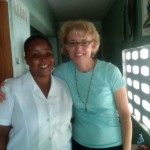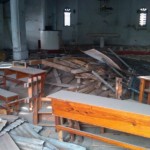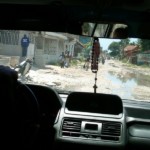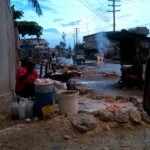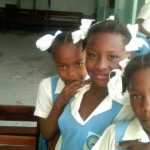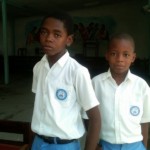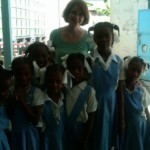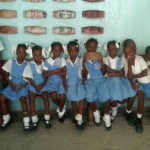Editor’s note – This is the first of several articles on the history of the Haiti mission from 2010 onward. This article is being originally published on Oct. 20, 2016, the day the current team departs for another medical mission.
Reliefweb in September 2011 described the effect of the January 12, 2010 earthquake which registered a magniture of 7.0, 15 miles southwest of Port-au-Prince.
“The Government of Haiti estimates that the earthquake killed 222,570 and injured another 300,572 people. Displacement peaked at close to 2.3 million people, including 302,000 children. At least 188,383 houses were badly damaged and 105,000 were destroyed by the earthquake. Sixty per cent of Government and administrative buildings, 80 per cent of schools in Port-au-Prince and 60 per cent of schools in the South and West Departments were destroyed or damaged. Total earthquake-related loss is estimated at $7.8 billion, equivalent to more than 120 per cent of Haiti’s 2009 gross domestic product.”
Disease was rampant. This was a devastating blow to the poorest nation in this hemisphere before the earthquake. Progress was steady but still by mid-2014, an estimated 104,000 people remained internally displaced in 172 camps
St. George’s became involved through the Diocese truck fund. Donations in excess of $216,000 from parishes, community organizations and individuals around Virginia supplied 10 small and fierce trucks for Episcopal Relief and Development (ERD) to support relief. The Outreach Commission targeted the Lenten offering go to Haitian relief through (ERD) and in particular the Haitian Truck Fund
Our involvement took another dimension when Carey Chirico was invited to travel to Haiti with Bishop Shannon. It was a Diocesan fact-finding mission to Haiti.
The Bishop on Nov. 1 reflected on his trip. The trip showed the distressing aspects of the earthquake but also how the officials were meeting the challenges. Schools had reopened in temporary facilities. “I saw bright spirits, I saw strengthened resolve”
2 conclusions:
1. He saw a lot of hands in faces, people showing the despair
2. The Episcopal church infrastructure is gone and their clergy is understaffed. There are only 40 clergy for 200 churches. However, Bishop Duracin is keeping the morale up, the ministries focused and making sure the church can rise to meet this unparalleled challenge.
Main thing we can do is to establish congregation to congregation links to help with the physical needs and to build a spiritual relationship as the body of Christ
He was able to report at Annual Council in 2011 that “16 of our congregations that are now either in links with the Diocese of Haiti or are actively considering establishing new links for long-term ministry there”
Carey wrote the following article for the Jan., 2011, Virginia Episcopalian:

On a recommendation from Carey, St. George’s was one of the churches to establish a church to church relationship. St. George’s vestry voted to establish a relationship with a congregation in Haiti assigned to Notre Dame in December 2010. On December 24th there was the first communication with our priest, Pere Jean Fils Chery. 75% of the Christmas fund was directed toward Haitian relief. The Haiti team was formed early in 2011
Carey reported to the Vestry in March 2011 several steps taken already and others planned:
- We helped the school pay teacher salaries through the donation of 3/4’s of the Christmas offering.
- A Church reading group on Haiti (Lenten Intergenerational Book Group) has been established with 4 books.
- There is a committee on the World Mission Commission that is considering a coffee fund raiser to heighten awareness of the needs of Haiti.
In May, 2011, Pere Jean Fils Chery traveled to Fredericksburg to visit with St. George’s and preach on Sunday
The way was paved for mission trips to establish a more active role for the church.
“Mission trips allow us to offer and communicate the love of God in Christ through hands on efforts and practical caring; in that spirit the World Mission Commission of St. George’s oversees, manages and raises funds for all national and international missions of our church; educates itself and the parish in matters of mission and potential mission; and financially supports the organization with whom we have a missionary relationship.”
Janice Brunson – October, 2011
1. June, 2011. First mission trip. In June Carey Chirico, Kevin Fisher, Emily Smith and Rev. Tom Hughes traveled to Haiti to meet with the Vestry of Notre dame and to see first hand life in Bolosse, Port au Prince and in our congregation.
On the return Tom Hughes made a report to the Vestry along with other participants.
Tom began the presentation by citing various stories where you can find Christ in the world. He found that situation to be in Haiti. He said our role in Haiti would be as partners and not as just providers as they have riches to give us. They have remained joyful and spiritual in the midst of deprivation and squalor despite being the poorest church in the poorest country in Latin America. How did they get this way ? That was one of the reasons for the journey there.
Emily Smith brought along 9 pictures of her trip. She related that the experience was truly humbling and it deepened her faith. We should gain a lot from this partnership. They worked mostly with students in middle school, attended church and met with the Vestry. They learned of the Church needs, both short and long range through those interactions.
One pressing need is an inverter system which stores electricity since they receive electricity only a few times a week (Such as gift has just been received from a parishioner but it was soon stolen.) Without electricity, it is dark in the classroom and they have to move the desks around to receive sufficient sunlight. Blackboards are constantly in the darker parts of the classroom.
Our goal is to provide within reason but empower the church to provide for themselves. They will also partner with a number of local churches in Virginia.
The school has an expanding population with 47 students in 1st grade and 150 total. They eat beans and rice every day and meat if available. There are no fruits and vegetables. It is the only meal for some of the children and it is not balanced. They need a feeding program. Any left over food is given to the community.
Their Church building was condemned after the earthquake. They have an outside structure used for the Church. The classrooms are partially intact as well as the administration buildings. However, the church is the place where the children want to be. The surrounding streets are appalling with trash and pigs roaming.
She encouraged the creation of a fundraising effort to provide the necessities of education. A single donation of $350 would pay for books, uniform, tuition, two meals a day and a teacher for one child. Only half of the students now pay only part of the tuition. The teachers have not been paid for 5 months.
There were 4 more trips in 2011-2012, the last being the first medical mission which became the direction of the mission
2. October 2011
Carey Chirico, Sarah Roeske, Emily Smith and Linda Wollensen traveled to Haiti to meet with the congregation and to meet with the TEC Health Committee.
“Our team arrived, purchased medicines for distribution on the mission day, conducted education with the parents and leadership of the school around the keeping of individual health records for the children and provided all with World Health Organization booklets to record immunization dates. They organized the medical clinic day for the school and oversaw the Clinics overall operation using all Haitian doctors and nurses. On Friday the assembled team gave check ups to the children of the school and on Saturday opened the doors to the community.
“The St George’s team gave medical attention to over 100 adults living in the community in addition to the 300 children of the school. It is important to realize that many in the area of our church will never see a doctor in their lifetime so the medical care we were able to organize and fund is a huge benefit to the church and its neighbors. One of the most direct benefits that our priests report is some decrease in gang violence in the neighborhood, particularly violence aimed at the church. More and more, Notre Dame with our support is helping its community and healing of the area is taking place as a result.
“Sat -. Spent Saturday with at the Bishop’s office with the Episcopal Diocese Health Committee so that Linda Wollesten could present her work with expectant first time mothers and offer to link her work with the Diocese using Episcopal Churches as centers for Home Empowerment Workers to work out of and using the Episcopal community of nurses and lay women as staff people.
“Monday – Monday we returned to the Church and school for a very short visit. During this time Sarah was able to see the school, collect information about current numbers and share letters from American third graders with the Haitian children. We talked about using a model of working groups that would independently work on the needs related to their area coming to the bigger group for disscussion of work, discussion of fundraising needs,
3. April, 2012
Sarah Roeske, Ben Shelton and Emily Smith traveled to Haiti to meet with the congregation, teachers and see the school in action.
4. August, 2012
Carey Chirico, Linda Wollensen and Rev. Stephen Shepherd traveled to Haiti to meet with congregation, meet our new priest – Pere Fanfan, and to see Jean Fils at his new congregation and to work on the health initiative started by Linda. They collected Children’s Vitamins to take with us for distribution by the school nurse


